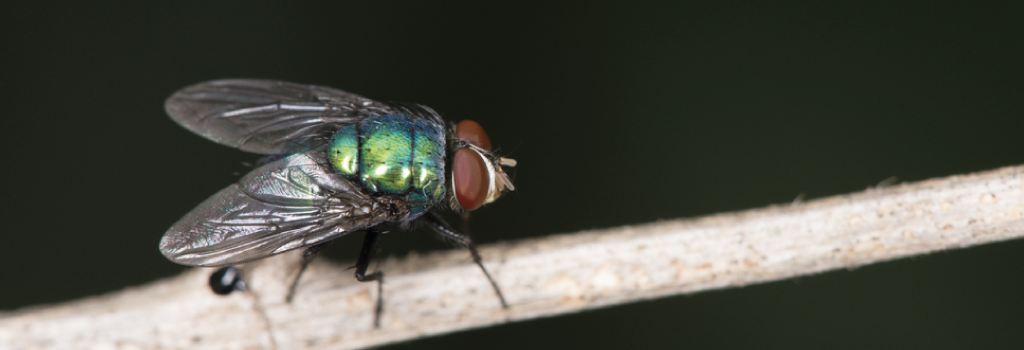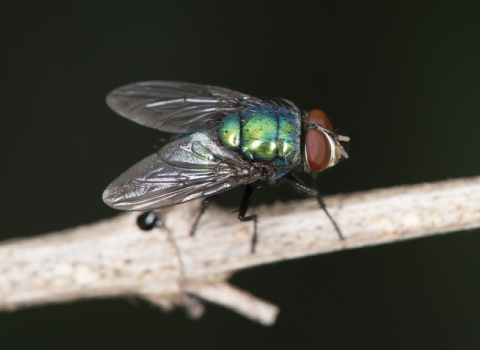Cluster Flies
Pollenia rudis
Homeowners are accustomed to swatting flies in the kitchen during the summer months. However, cluster flies make their debut in the autumn when they fly to the sunny sides of homes in search of protected over-wintering sites and may be found flying about inside, often in great numbers, throughout the winter. These flies are not reproducing within the structure, but become active on warm days and crawl out of wall voids and attics in a confused attempt to go back outside.
Cluster flies are thought to be native to Europe and may have found their way to North America in the ballast of ships containing soil and the cluster fly host, earthworms.
Description
Adult cluster flies are slightly larger than the common house fly, Musca domestica . They are dull-gray with black markings and have golden-yellow hairs on the thorax, which can give the appearance of a golden sheen. The hairs are more numerous on the under side of the thorax between and near the legs.
The immature stages, egg and larva, are seldom seen as the eggs are deposited on the soil and the larva or maggots burrow into earthworms on which they feed. The maggots are cream colored and are an elongated wedge shape. As members of the fly family Calliphoridae, the blow flies, the maggots resemble other blow flies commonly found on decaying carrion.
Life History
In Pennsylvania, there may be three to four, or more, generations of cluster flies per season. The adults leave their protected over-wintering sites in the spring and will lay eggs on the soil, which contains earthworms. The hatching larvae enter earthworms, develop to their last larval stage, pupate and emerge as adults to begin the cycle anew. With the onset of autumn, the current crop of adults will seek protected over-wintering sites in such locations as hedge rows; under the bark of dead and dying trees; in the crevices of south-facing cliffs and rock faces; and within the cracks, crevices and voids in sheds, garages, barns, houses and other man-made structures.
Damage
As a nuisance pest, Pollenia rudisjoins the ranks of other over-wintering pests such as the multicolored Asian lady beetle, the western conifer seed bug and the boxelder bug. Cluster flies will not damage your home. Occasionally, the flies may leave small dark-colored spots of excrement on windows and walls, but they are not known to carry any diseases of medical importance to humans. In addition to the ‘clustering’ on the sunny exterior of buildings in the fall, the flies will gather in large numbers at windows within the home on warm winter days. The flies are typically sluggish in flight and can be easily swatted or captured.
Management
Before cluster flies enter the structure – Mechanical exclusion is the best method to keep cluster flies from entering homes and buildings. Cracks around windows, doors, siding, utility pipes, behind chimneys, and underneath the fascia and other openings should be sealed with good quality silicone or silicone-latex caulk. Damaged screens on doors and windows should be repaired or replaced.
Exterior applications of insecticides may offer some relief from infestations where the task of completely sealing the exterior is difficult or impossible. Applications should consist of a synthetic pyrethroid (i.e. bifentrin, cyfluthrin, lambda-cyhalothrin, cypermethrin, deltamethrin, sumithrin or tralomethrin) or a neonicotinoid (dinotefuran) and should be applied by a licensed pest control operator in the autumn just prior to fly congregation. Unfortunately, because insecticides are broken down by sunlight, the residual effect of the material will be greatly decreased and may not kill the flies much beyond several days or a week.
After flies have gained access to attics and wall voids – It is not advisable to use an insecticide within structures after the flies have gained access to the wall voids or attic areas. Although insecticidal dust treatments to these voids may kill thousands of flies, there is the possibility that carpet beetles will feed on the dead insects and subsequently attack woolens, stored dry goods or other natural products in the home. Although aerosol-type pyrethrum foggers will kill cluster flies that have amassed in attic areas, it will not prevent flies from emerging from wall voids. For this reason use of these materials is not considered a good solution to long-term management of the problem. Spray insecticides, directed into cracks and crevices, will not prevent the flies from emerging and is not a viable or recommended treatment.
If numerous flies are entering the living areas of the home, attempt to locate the openings where the insects gain access. Typically, flies will emerge from cracks under or behind baseboards, around window and door trim, and around exhaust fans or lights in ceilings. Seal these openings with caulk or other suitable materials to prevent the insects from crawling out.




